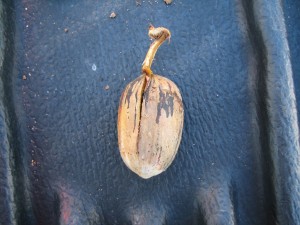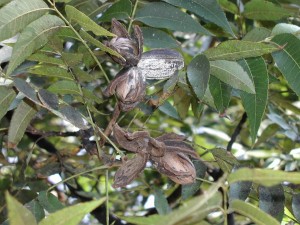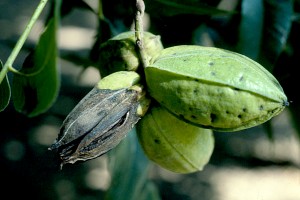Based on the concern generated by my last post I wanted to clarify the differences in some of the potential harvest season issues with pecan quality. The kernel rot discussed in the last post is an apparently new and separate issue from what we have seen in the past. Since I explained all we know at this point about it in the last post, I wanted to cover some other shuck and nut issues that can crop up during harvest.
The most commonly observed problems with nuts around harvest time are vivipary (sprouting), shuck decline, anthracnose, and phytopthora. These separate issues are often associated with each other and can be confusing.
Vivipary or sprouting occurs when a high percentage of nuts fail to open while the shucks remain green. In such cases, when the nuts have developed, the kernels remain extremely moist and the seed coat is darkened. In this situation, there is often an increase in the amount of nuts which germinate and sprout on the tree.
Vivipary often occurs under two conditions; (1) High humidity between the shell and shuck, and (2) high temperatures during ripening. The amount of vivipary varies with crop load, irrigation, tree crowding, soil depth, and length of the growing season. The longer the fruit remains on the tree, the greater the degree of vivipary.
If the kernel does not develop, the delayed shuck opening can be easily explained by the lack of ethylene, which is produced by the mature kernel and stimulates shuck split. A variety of factors may prevent kernel development. The cause of the delayed opening of green nuts with a mature kernel inside is unknown.
Shuck Decline can be a confusing problem, and may be serious under certain environmental conditions. When shuck decline occurs, the shuck deteriorates and may open prematurely. In this case the shuck may stick to the nut. Nuts affected by this problem appear black and may fall from the tree or remain in the cluster. Most of the affected nuts will be of poor quality. Most evidence points to fruiting stress as the primary cause of shuck decline. Shuck decline normally occurs on trees bearing heavy fruit loads, which can potentially stress pecan trees. Although apparent on many cultivars, shuck decline normally affects Success, Stuart, Cape Fear, Moneymaker, and other prolific cultivars.
When shuck decline occurs, the problem is often hastened by dry soil during and immediately after the kernel filling stage. This leaves pecan trees bearing heavy crop loads without a sufficient amount of water during the months of September and October when water is so very critical to the crop. In such situations, orchards may have had sufficient soil moisture to develop large nut size; however this makes the nuts more difficult to fill. As a result, irrigated orchards can suffer as much or more from shuck decline than dry-land orchards. Late season mite and aphid damage on already heavily loaded and moisture stressed trees can create further stress and likely played a large role in those orchards where this is a problem this year.
Many times disease pathogens are initially suspected as the primary problem when shuck decline occurs (most notably Phomopsis and Glomerella); however, usually when disease organisms are found on nuts with shuck decline the disease organism is only a secondary problem.
Anthracnose on the fruit appears as dark, sunken lesions along the sutures in the shuck or near the base of the nut where it is attached to the stem. Lesions can continue to spread and cover the fruit. Damage includes reduction in yield, quality, fruit drop and stick tights. Glomerella (and other fungi) are the cause of anthracnose.
Infection occurs early in fruit development but symptoms don’t appear until later in the season. Spores are often found even on healthy shucks during the season. Disease development is favored by excessive rain and temperatures near 68 degrees F. IN addition, anthracnose is associated with heavy crop load, excessive shade, and insect pressure.
Phytophthora shuck and kernel rot is a minor disease of pecan with the potential to cause significant crop loss. It occurs mostly in central and south Georgia, primarily in irrigated, mature pecan orchards. In late August through October of 1988, a severe outbreak affecting all major cultivars occurred in a few central Georgia counties, causing estimated yield losses of up to 50%.
The symptoms are distinctive, compared to those of other diseases of pecan fruit, and they change slightly as the fruit mature. Fruit rot starts at the stem end of the fruit and encircles the shuck, rapidly moving to the tip. The shuck may become rotted within 4 days, becoming soft and moist. The dead tissue is dark brown with distinct light brown margins. Shucks infected in late August or early September dry and stick tightly to the shell after about 2 weeks. Shucks of fruit infected in late September or October split more normally before drying. Infected kernels often have a dark seed coat, a rotted endosperm, and a bitter taste.
In general, Phytophthora fruit rot occurs following an extended wet period with moderate temperatures. The 1988 epidemic occurred in late summer following a 15-day period during which rain was recorded on 11 days and the maximum daily temperature exceeded 86 F only once. The fungus does not grow when temperatures exceed 86 F.




